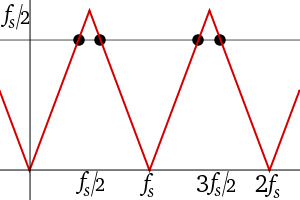Infinite dihedral group
| p1m1, (*∞∞) | p2, (22∞) | p2mg, (2*∞) |
|---|---|---|
 |
 |
 |
| In 2-dimensions three frieze groups p1m1, p2, and p2mg are isomorphic to the Dih∞ group. They all have 2 generators. The first has two parallel reflection lines, the second two 2-fold gyrations, and the last has one mirror and one 2-fold gyration. | ||
In mathematics, the infinite dihedral group Dih∞ is an infinite group with properties analogous to those of the finite dihedral groups.
In two dimensional geometry, the infinite dihedral group represents the frieze group symmetry, p1m1, seen as an infinite set of parallel reflections along an axis.
Definition
Every dihedral group is generated by a rotation r and a reflection; if the rotation is a rational multiple of a full rotation, then there is some integer n such that rn is the identity, and we have a finite dihedral group of order 2n. If the rotation is not a rational multiple of a full rotation, then there is no such n and the resulting group has infinitely many elements and is called Dih∞. It has presentations
and is isomorphic to a semidirect product of Z and Z/2, and to the free product Z/2 * Z/2. It is the automorphism group of the graph consisting of a path infinite to both sides. Correspondingly, it is the isometry group of Z (see also symmetry groups in one dimension), the group of permutations α: Z → Z satisfying |i - j| = |α(i) - α(j)|, for all i, j in Z.[2]
The infinite dihedral group can also be defined as the holomorph of the infinite cyclic group.
Aliasing

A concrete example of infinite dihedral symmetry is in aliasing of real-valued signals; this is realized as follows. If sampling a signal (signal processing term for a function) at frequency fs, then the functions sin(ft) and sin((f + fs)t) cannot be distinguished (and likewise for cos), which gives the translation (r) element – translation by fs (the detected frequency is periodic). Further, for a real signal, cos(−ft) = cos(ft) and sin(−ft) = −sin(ft), so every negative frequency has a corresponding positive frequency (this is not true for complex signals), and gives the reflection (f) element, namely f ↦ −f. Together these give further reflection symmetries, at 0.5fs, fs, 1.5fs, etc.; this phenomenon is called folding, as the graph of the detected signal "folds back" on itself, as depicted in the diagram at right.
Formally, the quotient under aliasing is the orbifold [0, 0.5fs], with a Z/2 action at the endpoints (the orbifold points), corresponding to reflection.
See also
- The orthogonal group O(2), another infinite generalization of the finite dihedral groups
Notes
- ↑ Connolly, Francis; Davis, James (August 2004). "The surgery obstruction groups of the infinite dihedral group" (PDF). Geometry & Topology. 8: 1043–1078. doi:10.2140/gt.2004.8.1043. Retrieved 2 May 2013.
- ↑ Meenaxi Bhattacharjee, Dugald Macpherson, Rögnvaldur G. Möller, Peter M. Neumann. Notes on Infinite Permutation Groups, Issue 1689. Springer, 1998. p. 38. ISBN 978-3-540-64965-6